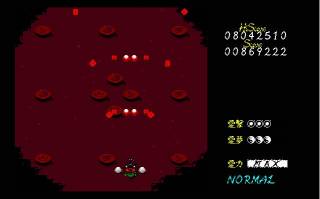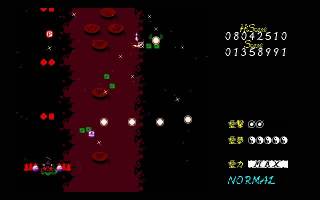Overview
The Story of Eastern Wonderland is the second game in the Touhou Project, released for the Japanese PC-98 in 1997. It was the first game to feature the Danmaku style of shooting, which has since became a staple of the series.
Plot
After finishing some training sessions in the mountains, Reimu Hakurei return to find that the Hakurei Shrine has been overrun by ghosts and Youkai. Eager to test her abilities after the training sessions, she takes the Hakurei Yin-Yang Orb and sets off on the back of her pet turtle, Genjii (who can both fly and speak), to find the source of the invasion.
Gameplay
The Story of Eastern Wonderland plays out like many other vertically scrolling Danmaku shooting games, with your character always facing the top of the screen, shooting at anything that moves while avoiding and weaving through the many bullet patterns, and facing bosses at the end of each stage.
There are four difficulties: Easy, Normal, Hard and Lunatic. Each difficulty affects the number of bullets fired by each enemy, the rate of fire, and the types of bullet patterns and their movement. Lunatic difficulty is an exception to this rule, however, as it is almost exactly the same as the Hard difficulty, with one difference: every stage enemy defeated will fire two fast moving bullets towards Reimu's position.
There are 5 stages in the game, each more difficult than the last. However, after clearing the game with all three attack types on any one difficulty, an Extra Stage will be unlocked. The Extra Stage features significantly stronger and fast enemies, an extremely hard boss battle, and no option to continue once all of your lives have been used up.
Defeating Enemies
Unlike
Highly Responsive to Prayers, Reimu can harm enemies directly through the use of two abilites:
ShotThe shot is the basic way of defeating an enemy. A shot's attack area and behaviour will vary depending on the Attack Type you have chosen, and you can also power up the shot by filling the Power Level through the collection of power items. The shot will gradually become more power as the player reaches the levels of 7, 15, 31, 39, 51, 63, and 79 (MAX). At MAX power, the shot will have a special ability, which varies on the Attack Type you have chosen.
BombsBombs can be used to get out of desperate situations. A bomb's attack area, duration and power will vary depending on the Attack Type you have selected, but most of the time, it will deal heavy damage to every enemy onscreen, as well as cancel out any onscreen bullets. While a bomb is activated, and a short period after it has finished, Reimu will be invincible. At the beginning of the game, and after every respawn, you will have 3 bombs. However, if there are no lives remaining after a respawn, you will have 5 bombs. You can increase your bomb supply through the collection of bomb items. You can carry a maximum of 5 bombs at a time, and if you collect a bomb item while at the limit, that bomb will be lost.
Unlike in later games in the series, if you activate a bomb at the same time that you have been hit, the bomb will most likely not activate, and you will lose a life.
Attack Types
In
The Story of Eastern Wonderland, there are 3 Attack Types: A, B and C. You choose which one to use when you begin the game.
 Attack Type A Max Power- Attack Type A
Attack Type A Max Power- Attack Type A (The Movement Type)
Movement Speed: ★★★★★
Attack Range: ★★★★★
Attack Power: ★
Bomb Duration: ★★★
MAX Power Ability: Shots will be able to penetrate enemies.
Summary: This Attack Type allows for quick movement, making it easy to avoid bullets and collect items, however, the low attack power will make boss battles rather lengthy.
 Attack Type B Max Power
Attack Type B Max Power-
Attack Type B (The Defence Type)
Movement Speed: ★★★
Attack Range: ★★★★
Attack Power: ★★★
Bomb Duration: ★★★★★
MAX Power Ability: Shots will auto-target enemies
Summary: This Attack Type is quite balanced, which is suitable for beginners.
 Attack Type C Max Power
Attack Type C Max Power-
Attack Type C (The Attack Type)
Movement Speed: ★
Attack Range: ★
Attack Power: ★★★★★
Bomb Duration: ★
MAX Power Ability: Shots will be able to penetrate enemies.
Summary: This Attack Type is excellent if you want to power through levels and bosses, however, item collection will be quite difficult.
Boss Battles
Unlike other games in the series, bosses have no health bars, timers or Spell Cards. Once you have dealt enough damage to a boss, it will change it's pattern of attack.
Scoring
The scoring system in
The Story of Eastern Wonderland is less complicated than those found in the other games in the series.
Enemies
Any damage dealt to you enemy, whether it be dealt by a shot or a bomb, will increase your score slightly. Defeating enemies will award you with a slightly more points, although these tend to range in the hundreds, per enemy.
Point Items
Whenever an enemy is defeated, there is a chance that it will release a point item. The higher up the screen you collect them, the more points that will be awarded, although there is a maximum value, which is based on the difficulty you are playing at. The number of point items collected in a stage is also used to calculate the Clear Bonus.
Power Items
Whenever an enemy is defeated, there is a chance that it will release a power item. The number of points you gain for these will be based on the difficulty you are playing at, and this is the number of point you will be awarded until your power level reaches MAX, where each additional power item collected will then be worth more than the last, until the maximum value per item, per difficulty is reached. Unlike point items, the points you gain from power items will always be the same anywhere on the screen.
Clear Bonus
At the end of each stage, you will be provided with bonus points based on how well you performed. The bonus is calculated like this:
Difficulty:
Easy - 0
Normal - 2,000
Hard - 4,000
Lunatic - 6,000
Is added to:2,500 - (Number of Bombs used in the stage x 500)
3,000 - (Number of lives lost in the stage x 1,000)
(The number of initial bombs) x 800
(The number of initial lives) x 1,000
The combined total is then multiplied by the number of point items collected during that stage.
Music
In
The Story of Eastern Wonderland, every stage has different music, while every boss has their own theme. The translated name of each theme is provided below the original version:
- Title Screen Theme東方封魔録 〜浄土曼荼羅
- Stage 1 Theme博麗 〜Eastern Wind
Hakurei ~ Eastern Wind
- Stage 1 Boss: Rika's ThemeShe's in a Temper!!
- Stage 2 ThemeEnd of Daylight
- Stage 2 Boss: Meira's Themeやみのちから
Power of Darkness
- Stage 3 Theme幻夢界
World of Empty Dreams
- Stage 3 Boss: The 5 Magic Stones' Theme死を賭して
Bet on Death
- Stage 4 Themeひもろぎ、むらさきにもえ
Himorogi, Be Burnt Purply
- Stage 4 Boss: Marisa Kirisame's Theme恋色マジック
Love-coloured Magic
- Final Stage Theme東方封魔録 〜幽幻乱舞
Recorded Sealing of an Oriental Demon ~ A Phantom's Boisterous Dance
- Final Stage Boss: Mima's ThemeComplete Darkness
- Extra Stage Themeエキストララブ
Extra Love
- Extra Stage Boss: Rika's 2nd Theme戦車むすめのみるゆめ
The Aggressive Daughter's Visionary Dream
- Ending Theme遠野の森
Forest of Tohno
- Staff Roll Theme昔話わんだーらんど
Legendary Wonderland
Unused Music
The Story of Eastern Wonderland also has 3 theme which were never included in the final version of the game:
博麗神社境内
Hakurei Shrine Grounds
陽落ちて
Sunfall
封魔終演
Sealed Demon's Finale
Endings
The Story of Eastern Wonderland has 6 different endings, each one being triggered through meeting a certain criteria.
Good Endings
The good endings are achieved when the player beats the game without using any continues:
- Good Ending ABeat the game without using any continues, using Reimu Type A
- Good Ending B Beat the game without using any continues, using Reimu Type B
- Good Ending C Beat the game without using any continues, using Reimu Type C
Bad Endings
The bad endings are achieved when the player beats the game, but has used one or more continues:
- Bad Ending ABeat the game using one or more continues, using Reimu Type A
- Bad Ending B Beat the game using one or more continues, using Reimu Type B
- Bad Ending C Beat the game using one or more continues, using Reimu Type C
Log in to comment